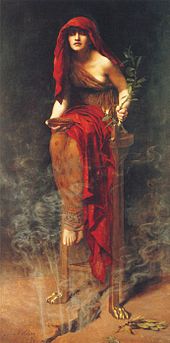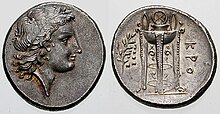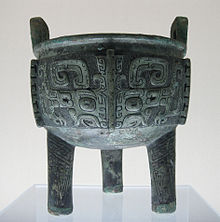|
Greek City of Pergamon in Asia Minor
Regal Bronze Coinage of Pergamon
Bronze 12mm (1.08 grams) Struck circa 282-133 B.C.
Reference: Sear 7232
Laureate head of Apollo right.
ΦΙΛE / TAIPOY either side of tripod.
This issue is inscribed with the name of the dynasty’s founder, Philetairos, and
firm attributions to particular reigns are not yet possible.
Situated in the Kaikos valley, about 15 miles from the coast, Pergamon was a
city of uncertain origin and of no great importance before the time of Alexander
the Great. In the 3rd century B.C. it became the center of the independent
kingdom ruled by the Attalid dynasty founded by Philetairos. The city was
extended and beautified as the prosperity of the kingdom increased, and by the
late Hellenistic times Pergamon ranked as one of the great cultural centers of
the Greek world. After the end of the kingdom, 133 B.C., Pergamon became capital
of the Roman province of Asia.
You are bidding on the exact item pictured,
provided with a Certificate of Authenticity and Lifetime Guarantee of
Authenticity.
A sacrificial tripod is a three-legged piece of religious furniture
used for offerings or other ritual procedures. As a seat or stand, the
tripod
is the most stable furniture
construction for uneven ground, hence its use is universal and ancient. It is
particularly associated with
Apollo
and the
Delphic oracle
in
ancient Greece
, and the word “tripod” comes
from the Greek meaning “three-footed.”

Apollo and
Heracles
struggle for the Delphic
tripod (Attic
black-figure
hydria
, c. 520 BC)
Ancient Greece
The most famous tripod of ancient Greece was the
Delphic
tripod from which the
Pythian priestess
took her seat to deliver the
oracles
of the deity. The seat was formed by a
circular slab on the top of the tripod, on which a branch of
laurel
was deposited when it was unoccupied by
the priestess. In this sense, by Classical times the tripod was sacred to
Apollo
. The
mytheme
of
Heracles
contesting with Apollo for the tripod
appears in vase-paintings older than the oldest written literature. The oracle
originally may have been related to the primal deity, the Earth.

Priestess of Delphi (1891), as imagined by
John Collier
; the Pythia is
inspired by
pneuma
rising from below as she
sits on a tripod
Another well-known tripod in Delphi was the
Plataean Tripod
; it was made from a tenth part
of the spoils taken from the
Persian
army after the
Battle of Plataea
. This consisted of a golden
basin, supported by a
bronze
serpent
with three heads (or three serpents
intertwined), with a list of the states that had taken part in the war inscribed
on the coils of the serpent. The golden bowl was carried off by the
Phocians
during the
Third Sacred War
(356–346 BC); the stand was
removed by the emperor
Constantine
to
Constantinople
in 324, where in modern
Istanbul
it still can be seen in the
hippodrome
, the Atmeydanı, although in
damaged condition: the heads of the serpents have disappeared, however one is
now on display at the nearby Istanbul Archaeology Museums. The inscription,
however, has been restored almost entirely. Such tripods usually had three
ears (rings which served as handles) and frequently had a central upright as
support in addition to the three legs.
Tripods frequently are mentioned by
Homer
as prizes in
athletic games
and as complimentary gifts; in
later times, highly decorated and bearing inscriptions, they served the same
purpose. They also were used as dedicatory
offerings
to the deities, and in the dramatic
contests at the Dionysia
the victorious
choregus
(a wealthy citizen who bore the
expense of equipping and training the chorus) received a crown and a tripod. He
would either dedicate the tripod to some deity or set it upon the top of a
marble structure erected in the form of a small circular temple in a street in
Athens
, called the street of tripods,
from the large number of memorials of this kind. One of these, the
Choragic Monument of Lysicrates
, erected by him
to commemorate his victory in a dramatic contest in 335 BC, still stands. The
form of the victory tripod, now missing from the top of the Lysicrates monument,
has been rendered variously by scholars since the 18th century.

An ancient Greek coin c. 330-300 BC. Laureate head of Apollo (left)
and ornate tripod (right).
Martin L. West
writes that the sibyl at Delphi
shows many traits of
shamanistic
practices, likely inherited or
influenced from Central Asian practices. He cites her sitting in a cauldron on a
tripod, while making her prophecies, her being in an ecstatic trance state,
similar to shamans, and her utterings, unintelligible.
According to Herodotus (The Histories, I.144), the victory tripods were not
to be taken from the temple sanctuary precinct, but left there as dedications.
Sometimes the tripod was used as a support for a
lebes
or cauldron or for supporting other items
such as a vase.
-
Delphic tripod (red-figured
bell-krater
,
Paestum
, c. 330 BC)
Ancient China

A
ding
from the late
Shang Dynasty
.
Tripod pottery have been part of the archaeological assemblage in China since
the earliest Neolithic cultures of
Cishan
and
Peiligang
in the 7th and 8th millennium BC.
Sacrificial tripods were also found in use in ancient
China
usually cast in bronze but sometimes
appearing in ceramic form. They are often referred to as “dings”
and usually have three legs, but in some usages have four legs.
The Chinese use sacrificial tripods in modern times, such as in 2005, when a
“National Unity Tripod” made of bronze was presented by the central Chinese
government to the government of northwest China’s
Xinjiang Uygur Autonomous Region
to mark its
fiftieth birthday. It was described as a traditional Chinese sacrificial vessel
symbolizing unity.

In
Greek
and
Roman mythology
, Apollo
,
is one of the most important and diverse of the
Olympian deities
. The ideal of the
kouros
(a
beardless youth), Apollo has been variously recognized as a god of light and the
sun; truth and prophecy;
archery
;
medicine and healing; music, poetry, and the arts; and more. Apollo is the son
of Zeus
and
Leto, and has a
twin
sister, the chaste huntress
Artemis
.
Apollo is known in Greek-influenced
Etruscan mythology
as Apulu. Apollo was worshiped in both
ancient Greek
and
Roman religion
, as well as in the modern
Greco
–Roman
Neopaganism
.
As the patron of Delphi
(Pythian Apollo), Apollo was an
oracular
god — the prophetic deity of the
Delphic Oracle
.
Medicine and healing were associated with Apollo, whether through the god
himself or mediated through his son
Asclepius
,
yet Apollo was also seen as a god who could bring ill-health and deadly
plague
as well as one who had the ability to cure. Amongst the god’s
custodial charges, Apollo became associated with dominion over
colonists
, and as the patron defender of herds and flocks. As the leader of
the Muses
(Apollon
Musagetes) and director of their choir, Apollo functioned as the patron god
of music and poetry
.
Hermes
created
the lyre
for him,
and the instrument became a common
attribute
of Apollo. Hymns sung to Apollo were called
paeans
.
In Hellenistic times, especially during the third century BCE, as Apollo
Helios he became identified among Greeks with
Helios
,
god of
the sun
, and his sister Artemis similarly equated with
Selene
,
goddess
of the moon
.
In Latin texts, on the other hand, Joseph Fontenrose declared himself unable to
find any conflation of Apollo with
Sol
among the
Augustan poets
of the first century, not even in the conjurations of
Aeneas
and
Latinus
in
Aeneid
XII
(161–215).
Apollo and Helios/Sol remained separate beings in literary and mythological
texts until the third century CE.
A sacrificial tripod was a type of
altar
used by the
ancient Greeks. The most famous was the
Delphic
tripod
, on
which the Pythian
priestess
took her seat to deliver the
oracles
of the
deity. The seat was formed by a circular slab on the top of the tripod, on which
a branch of
laurel
was deposited when it was unoccupied by the priestess. In this sense,
by Classical times the tripod was sacred to
Apollo
. The
mytheme
of
Heracles
contesting with Apollo for the tripod appears in vase-paintings older than the
oldest written literature. The oracle originally may have been related to the
primal deity, the Earth.
Another well-known tripod was the
Plataean Tripod
, made from a tenth part of the spoils taken from the
Persian
army after the
Battle of Plataea
. This consisted of a golden basin, supported by a
bronze
serpent
with three heads (or three serpents intertwined), with a list of the
states that had taken part in the war inscribed on the coils of the serpent. The
golden bowl was carried off by the
Phocians
during
the
Third Sacred War
; the stand was removed by the emperor
Constantine
to
Constantinople
(modern
Istanbul
),
where it still can be seen in the
hippodrome
, the Atmeydanı, although in damaged condition, the heads
of the serpents disappeared however one is now on display at the nearby Istanbul
Archaeology Museums. The inscription, however, has been restored almost
entirely. Such tripods usually had three ears (rings which served as
handles) and frequently had a central upright as support in addition to the
three legs.
Tripods frequently are mentioned by
Homer
as prizes
in
athletic games
and as complimentary gifts; in later times, highly decorated
and bearing inscriptions, they served the same purpose. They also were used as
dedicatory offerings
to the deities, and in the dramatic contests at the
Dionysia
the victorious
choregus
(a wealthy citizen who bore the expense of equipping and training
the chorus) received a crown and a tripod. He would either dedicate the tripod
to some deity or set it upon the top of a marble structure erected in the form
of a small circular temple in a street in
Athens
, called
the street of tripods, from the large number of memorials of this kind.
One of these, the
Choragic Monument of Lysicrates
, erected by him to commemorate his victory
in a dramatic contest in
335 BC
, still
stands. The form of the victory tripod, now missing from the top of the
Lysicrates monument, has been rendered variously by scholars since the
eighteenth century.
The scholar
Martin L. West
writes that the sibyl at Delphi shows many traits of
shamanistic
practices, likely inherited or influenced from Central Asian
practices. He cites her sitting in a cauldron on a tripod, while making her
prophecies, her being in an ecstatic trance state, similar to shamans, and her
utterings, unintelligible.
According to Herodotus (The Histories, I.144), the victory tripods were not
to be taken from the temple sanctuary precinct, but left there for dedication.
Pergamon, Pergamum or Pérgamo (in
Greek
, Πέργαμος) was an ancient
Greek
city in modern-day
Turkey
, in
Mysia
, today
located 16 miles (26 km) from the
Aegean Sea
on a promontory
on the north side of the river
Caicus
(modern day
Bakırçay
),
that became the capital of the
Kingdom of Pergamon
during the
Hellenistic period
, under the
Attalid dynasty
, 281–133 BC. Today, the main sites of ancient Pergamon are
to the north and west of the modern city of
Bergama
.
//
History

The
Kingdom of Pergamon
(colored olive), shown at its
greatest extent in
188 BC
The
Attalid
kingdom was the
rump state
left after the collapse of the
Kingdom of Thrace
.
The Attalids, the descendants of Attalus, father of
Philetaerus
who came to power in 281 BC following the collapse of the
Kingdom of Thrace, were among the most loyal supporters of
Rome
in the Hellenistic world. Under
Attalus I
(241-197 BC), they allied with Rome against
Philip V of Macedon
, during the
first
and
second
Macedonian Wars
, and again under
Eumenes II
(197-158 BC), against
Perseus of Macedon
, during the
Third Macedonian War
. For support against the
Seleucids
, the
Attalids
were rewarded with all the former Seleucid domains in
Asia Minor
.
The Attalids ruled with intelligence and generosity. Many documents survive
showing how the Attalids would support the growth of towns through sending in
skilled artisans and by remitting taxes. They allowed the Greek cities in their
domains to maintain nominal independence. They sent gifts to Greek cultural
sites like Delphi
,
Delos
, and
Athens
. They
defeated the invading Celts
. They remodeled the
Acropolis of Pergamo
after the
Acropolis
in Athens. When
Attalus III
(138-133 BC) died without an heir in 133 BC he bequeathed the
whole of Pergamon to Rome, in order to prevent a civil war.
According to Christian tradition, the first bishop of Pergamon,
Antipas
, was martyred there in ca. 92 AD. (Revelation
2:13)
The
Ottoman
Sultan
Murad III
had two large alabaster
urns transported from the ruins of Pergamon and placed on two
sides of the nave in the
Hagia
Sophia
in Istanbul
.[1]
Notable
structures
Upper
Acropolis

The Great Altar of Pergamon, on display in the
Pergamonmuseum
in
Berlin
,
Germany

Model of the Acropolis in the Pergamonmuseum in Berlin

Sketched reconstruction of ancient Pergamon
The
Great Altar of Pergamon
is in the
Pergamon Museum
, Berlin. The base of this altar remains on the upper part of
the Acropolis. It was perhaps to this altar, believed dedicated to Zeus, that
John of Patmos referred to as “Satan’s Throne” in his Book of Revelation
(Revelation 2:12-13).
Other notable structures still in existence on the upper part of the
Acropolis include:
Pergamon’s library on the Acropolis (the ancient
Library of Pergamum
) is the second best in the ancient Greek civilization.[4]
When the
Ptolemies
stopped exporting
papyrus
,
partly because of competitors and partly because of shortages, the Pergamenes
invented a new substance to use in
codices
, called
pergaminus or pergamena (parchment)
after the city. This was made of fine
calfskin
, a
predecessor of
vellum
. The library at Pergamom was believed to contain 200,000 volumes,
which Mark Antony
later gave to
Cleopatra
as a wedding present.
Lower
Acropolis
The lower part of the Acropolis has the following structures:
- the Upper Gymnasium
- the Middle Gymnasium
- the Lower Gymnasium
- the Temple of
Demeter
- the Sanctuary of
Hera
- the House of Attalus
- the Lower Agora and
- the Gate of
Eumenes
Sanctuary
of Asclepius
Three kilometers south of the Acropolis, down in the valley, there was the
Sanctuary of Asclepius
(also known as the
Asclepieion
), the god of healing. In this place people with health problems
could bathe in the water of the sacred spring, and in the patients’ dreams
Asclepius would appear in a vision to tell them how to cure their illness.
Archeology has found lots of gifts and dedications that people would make
afterwards, such as small terracotta body parts, no doubt representing what had
been healed. Notable extant structures in the Asclepieion include:
- the Roman theater
- the North Stoa
- the South Stoa
- the Temple of Asclepius
- a circular treatment center (sometimes known as the Temple of
Telesphorus)
- a healing spring
- an underground passageway
- a library
- the Via Tecta (or the Sacred Way, which is a colonnaded street leading
to the sanctuary) and
- a
propylon
.
Serapis
Temple
Pergamon’s other notable structure is the
Serapis
Temple (Serapeum)
which was later transformed into the Red Basilica complex (or Kizil Avlu in
Turkish), about one kilometer south of the Acropolis. It consists of a main
building and two round towers. In the first century AD, the
Christian
Church at Pergamon inside the main building of the Red Basilica
was one of the
Seven Churches
to which the
Book of Revelation
was addressed (Revelation
2:12). The forecourt is still supported by the 193 m wide
Pergamon Bridge
, the largest bridge substruction of antiquity.[5]
|





















